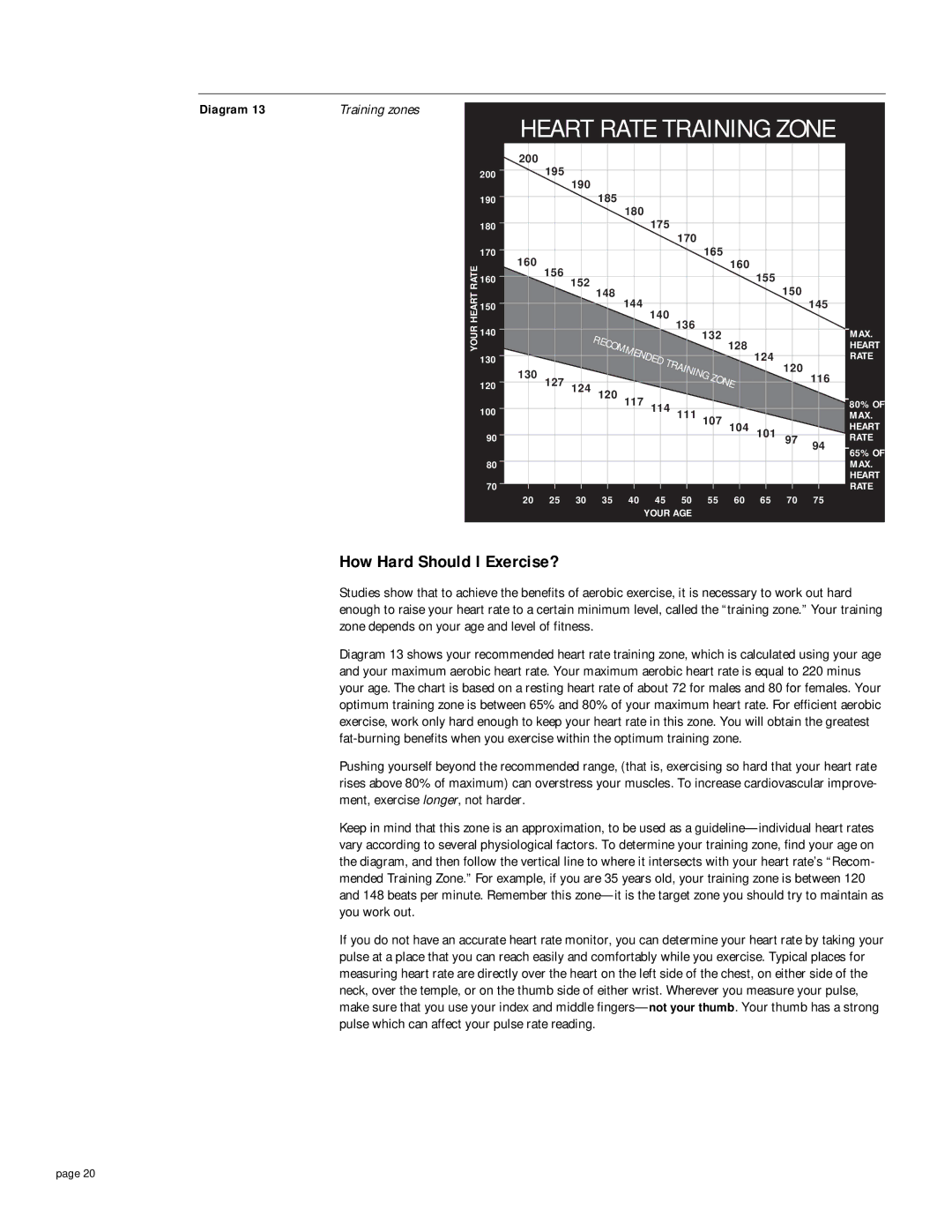
Diagram 13 | Training zones |
|
| HEART RATE TRAINING ZONE |
| |||||||||||
|
| 200 | 195 |
|
|
|
|
|
|
|
|
|
|
|
| 200 |
| 190 |
|
|
|
|
|
|
|
|
|
| |
|
|
|
| 185 |
|
|
|
|
|
|
|
|
| |
| 190 |
|
|
| 180 |
|
|
|
|
|
|
| ||
|
|
|
|
|
|
|
|
|
|
|
|
| ||
| 180 |
|
|
|
|
| 175 | 170 |
|
|
|
|
|
|
| 170 |
|
|
|
|
|
| 165 |
|
|
|
|
| |
| 160 |
|
|
|
|
|
| 160 |
|
|
|
| ||
RATE |
| 156 152 |
|
|
|
|
| 155 |
|
|
| |||
160 |
| 148 |
|
|
|
|
| 150 |
|
| ||||
HEART | 150 |
|
|
| 144 |
|
|
|
|
| 145 |
| ||
|
|
|
| 140 |
|
|
|
|
|
| ||||
|
|
|
|
|
| 136 |
|
|
|
|
|
| ||
YOUR | 140 |
|
|
|
|
|
| 132 |
|
|
|
| MAX. | |
|
|
|
|
|
|
| 128 |
|
|
| ||||
|
|
|
|
|
|
|
|
| 124 |
|
| HEART | ||
| 130 | 130 |
|
|
|
|
|
|
|
| 120 |
| RATE | |
|
| 127 |
|
|
|
|
|
|
|
| 116 |
| ||
| 120 | 124 | 120 |
|
|
|
|
|
|
|
| |||
|
|
|
| 117 | 114 |
|
|
|
|
|
| 80% OF | ||
| 100 |
|
|
|
| 111 107 |
|
|
|
| ||||
|
|
|
|
|
|
|
|
|
| MAX. | ||||
|
|
|
|
|
|
|
| 104 |
|
|
| |||
|
|
|
|
|
|
|
|
|
| 101 | 97 |
| HEART | |
| 90 |
|
|
|
|
|
|
|
| 94 | RATE | |||
|
|
|
|
|
|
|
|
|
|
|
|
| 65% OF | |
|
|
|
|
|
|
|
|
|
|
|
|
|
| |
| 80 |
|
|
|
|
|
|
|
|
|
|
|
| MAX. |
|
|
|
|
|
|
|
|
|
|
|
|
|
| HEART |
| 70 | 20 | 25 | 30 | 35 | 40 | 45 | 50 | 55 | 60 | 65 | 70 | 75 | RATE |
|
|
| ||||||||||||
|
|
|
|
|
|
| YOUR AGE |
|
|
|
|
|
| |
How Hard Should I Exercise?
Studies show that to achieve the benefits of aerobic exercise, it is necessary to work out hard enough to raise your heart rate to a certain minimum level, called the “training zone.” Your training zone depends on your age and level of fitness.
Diagram 13 shows your recommended heart rate training zone, which is calculated using your age and your maximum aerobic heart rate. Your maximum aerobic heart rate is equal to 220 minus your age. The chart is based on a resting heart rate of about 72 for males and 80 for females. Your optimum training zone is between 65% and 80% of your maximum heart rate. For efficient aerobic exercise, work only hard enough to keep your heart rate in this zone. You will obtain the greatest
Pushing yourself beyond the recommended range, (that is, exercising so hard that your heart rate rises above 80% of maximum) can overstress your muscles. To increase cardiovascular improve- ment, exercise longer, not harder.
Keep in mind that this zone is an approximation, to be used as a
If you do not have an accurate heart rate monitor, you can determine your heart rate by taking your pulse at a place that you can reach easily and comfortably while you exercise. Typical places for measuring heart rate are directly over the heart on the left side of the chest, on either side of the neck, over the temple, or on the thumb side of either wrist. Wherever you measure your pulse, make sure that you use your index and middle
page 20
